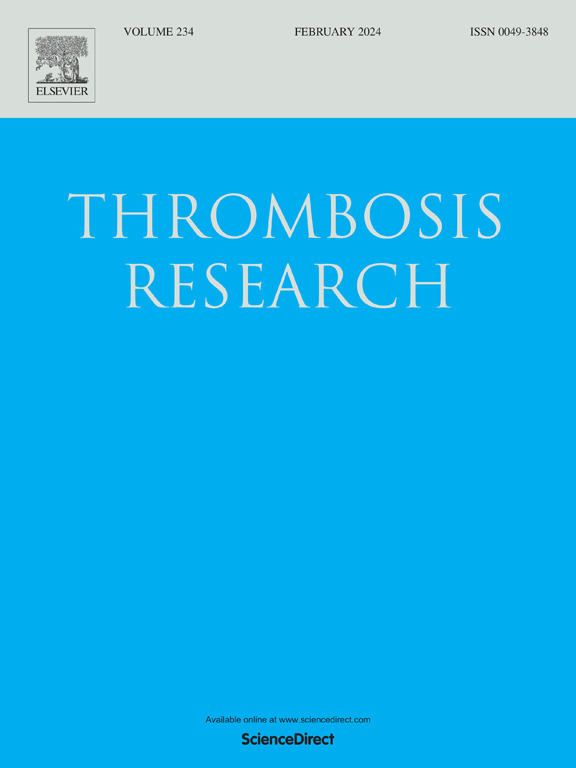Evaluation of modified pediatric sepsis-induced coagulopathy score in pediatric septic shock
IF 3.7
3区 医学
Q1 HEMATOLOGY
引用次数: 0
Abstract
Background
Sepsis-induced coagulopathy (SIC) is highly prevalent and plays an important role in the pathophysiology of sepsis. However, validated assessment tools for pediatric SIC under the 2024 pediatric sepsis criteria remain lacking. This study aimed to develop and validate a modified pediatric SIC (pSIC) score based on the Phoenix Sepsis Score (PSS) and evaluate its diagnostic and prognostic utility in children.
Methods
This retrospective study enrolled pediatric patients with septic shock admitted to the Pediatric Intensive Care Unit of Children's Hospital of Chongqing Medical University between May 2015 and August 2023. A modified pSIC score was developed by replacing the Sequential Organ Failure Assessment (SOFA) score with the PSS based on the existing adult SIC criteria.
Results
Among 432 pediatric patients with septic shock, those with elevated modified pSIC score demonstrated significantly worse baseline characteristics and higher risks of adverse outcomes. The modified pSIC score exhibited higher predictive value for 28-day mortality compared to previous scores and maintained good predictive ability and high sensitivity for overt DIC. Survival curves confirmed significantly higher 28-day mortality in the high pSIC group than in the low pSIC group (38.2 % vs 12.8 %, p < 0.001).
Conclusions
In this single-center cohort of pediatric septic shock patients, the modified pSIC score demonstrated good diagnostic and prognostic utility for sepsis-induced coagulopathy under updated sepsis criteria. However, its effectiveness still needs to be further validated in broader pediatric sepsis population.
改良小儿脓毒症致凝血功能评分在小儿脓毒症休克中的评价
背景:脓毒症诱导凝血病(SIC)非常普遍,在脓毒症的病理生理中起着重要作用。然而,在2024年儿童败血症标准下,儿科SIC的有效评估工具仍然缺乏。本研究旨在开发和验证基于Phoenix脓毒症评分(PSS)的改良儿童SIC (pSIC)评分,并评估其在儿童中的诊断和预后效用。方法回顾性研究2015年5月至2023年8月重庆医科大学附属儿童医院儿科重症监护室收治的感染性休克患儿。修改后的pSIC评分是基于现有的成人SIC标准,用PSS取代序贯器官衰竭评估(SOFA)评分。结果在432例感染性休克患儿中,改良pSIC评分升高的患儿表现出较差的基线特征和较高的不良结局风险。改良后的pSIC评分对28天死亡率的预测价值更高,对显性DIC保持良好的预测能力和高敏感性。生存曲线证实高pSIC组28天死亡率明显高于低pSIC组(38.2% vs 12.8%, p <;0.001)。结论:在这个儿童脓毒症休克患者的单中心队列中,修改后的pSIC评分在更新的脓毒症标准下对脓毒症诱导的凝血病具有良好的诊断和预后价值。然而,其有效性仍需要在更广泛的儿童败血症人群中进一步验证。
本文章由计算机程序翻译,如有差异,请以英文原文为准。
求助全文
约1分钟内获得全文
求助全文
来源期刊

Thrombosis research
医学-外周血管病
CiteScore
14.60
自引率
4.00%
发文量
364
审稿时长
31 days
期刊介绍:
Thrombosis Research is an international journal dedicated to the swift dissemination of new information on thrombosis, hemostasis, and vascular biology, aimed at advancing both science and clinical care. The journal publishes peer-reviewed original research, reviews, editorials, opinions, and critiques, covering both basic and clinical studies. Priority is given to research that promises novel approaches in the diagnosis, therapy, prognosis, and prevention of thrombotic and hemorrhagic diseases.
 求助内容:
求助内容: 应助结果提醒方式:
应助结果提醒方式:


